what is the variance? what is the standard deviation, rounded to the nearest whole number?

Standard deviation (SD) measured the volatility or variability beyond a set up of data. It is the measure of the spread of numbers in a information set from its hateful value and can be represented using the sigma symbol (σ). The post-obit algorithmic calculation tool makes information technology easy to quickly discover the hateful, variance & SD of a information set.
Math Formulas
- Mean = sum of values / N (number of values in ready)
- Variance = ((northwardi- Hateful)2 + ... nn- Mean)2) / N-1 (number of values in set up - 1)
- Standard Deviation σ = √Variance
- Population Standard Departure = apply North in the Variance denominator if y'all have the total data prepare. The reason 1 is subtracted from standard variance measures in the before formula is to widen the range to "correct" for the fact you are using only an incomplete sample of a broader data set up.
Example Adding
for data set 1,viii,-iv,ix,6 compute the SD and the population SD.
SD Calculation
Sum:
i+viii+-4+nine+half dozen=20
Mean:
20/5 numbers =
mean of four
Variance:
((i-four)ii + (8-four)two + (-4-4)2 + (nine-iv)2 + (six-iv)two) / (N-ane) =
((-iii)2 +( 4)2 + (-8)2 + (5)two + (2)2 ) / four =
(nine+16+64+25+4)/four =
118/4 = 29.5
Standard Deviation:
√29.v= 5.43139
Population SD Adding
Population Standard Deviation Variance:
((i-four)two + (8-4)2 + (-four-4)ii + (ix-four)ii + (6-4)2) / N =
((-three)2 +( iv)2 + (-eight)2 + (five)2 + (two)2 ) / 5 =
(9+sixteen+64+25+4) / five =
118 / v = 23.half dozen
Population Standard Deviation:
√23.6= four.85798
Standard Deviation: What It Is, Importance, and Existent-Earth Uses
- Guide Authored by Corin B. Arenas, published on October 10, 2019
Ever wondered how far the difference is between an excellent Sat score and a bad one? What well-nigh global economic inequality stats? How about the risk involved in making investments?
If y'all're still request these questions, y'all've come to the right place. In this section, you'll learn how to make up one's mind standard difference, why information technology's important, and its practical uses in the real world.
What is Standard Deviation?

In statistics, standard deviation (SD) is a measure out of how spread out numbers are in a given set, showing points of variation. It tells u.s. to what degree a fix of numbers are dispersed around an average.
The dispersion is the difference between the bodily value and the average value in a set. Basically, the wider the dispersion, the higher the standard deviation.
Its value is represented by the Greek letter sigma (σ), showing how much of the data is spread around the hateful (besides referred to as the boilerplate).
SD tin can range from 0 to infinity. Getting a 0 indicates that a gear up of numbers are all equal, which signifies they don't spread apart to any caste at all.
What is a Hateful? It is the mathematical average of all numbers in a prepare represented past the Greek letter mu (µ). To calculate the mean, add up the values of all the numbers then divide it by the total number of values in a given set.
Mean = sum of all values / N (number of values in set)
What Does Standard Deviation Suggest?
- Low SD indicates that the numbers are close to the mean fix.
- Loftier SD signifies that the numbers are dispersed at a wider range.
To better empathise SD, nosotros should visualize how it translates into a graph. In particular, let's talk over the normal distribution graph, otherwise known as the bell bend.
The Bell Curve and Deviations from the Mean

In a perfectly normal distribution, majority of the data points are relatively similar. It looks symmetrical, which means half of the data observations are on either side of the graph. It indicates that the data falls within a range of values with few outliers on the low or high points of the graph.
Elements of Normal Distribution:
- Has a hateful, median, or manner. A mean is the average of numbers in a group, a median is the heart number in a list of numbers, and a manner is a number that appears most oftentimes in a set of numbers.
- 50% of the values are less than the hateful
- l% of the values are greater than the mean
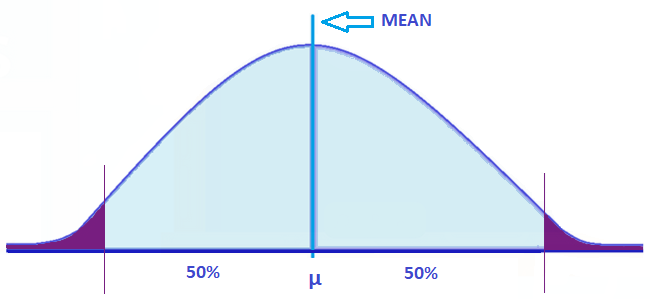
A normal distribution bend is also a theoretical representation of how frequently an experiment will yield a detail result.
How does standard deviation look in a normal distribution graph? See example image below.
Each colored section represents ane standard deviation from the mean. For instance, 1σ signifies i standard deviation away from the mean, then on. Likewise, -1σ is also i standard deviation abroad from the hateful, just in the opposite direction.
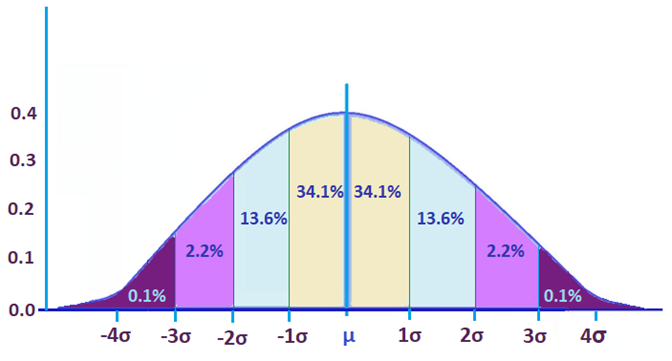
The percentages represent how much data falls within each department. In this case, 34.1% of the information occurs within a range of ane standard departure from the mean. Since it mirrors the other half of the graph, 34.i% of the data also occurs -1σ from the mean.
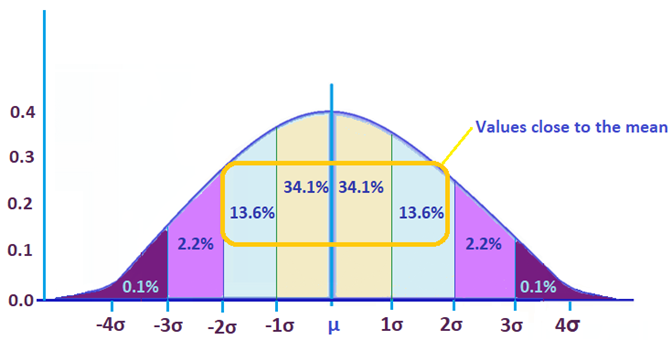
This graph above shows majority of the information, 95.v%, falls closer to the hateful. This indicates it has low standard difference.
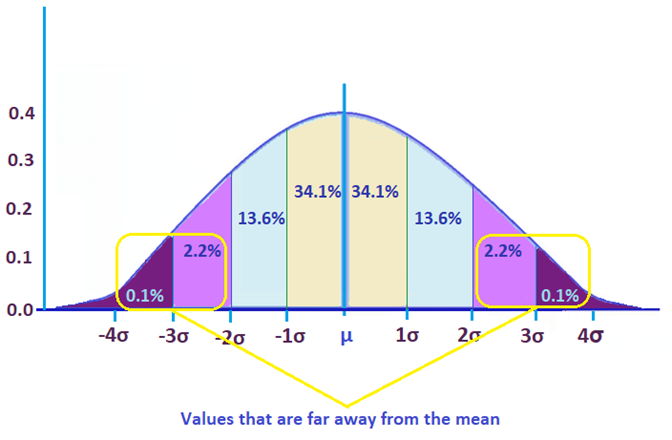
The graph higher up shows that only 4.6% of the data occurred after 2 standard deviations.
Moreover, information tends to occur in a typical range under a normal distribution graph:
- Around 68% fall between -one and 1
- Around 95% fall betwixt -2 and 2
- Around 99% fall between -3 and 3
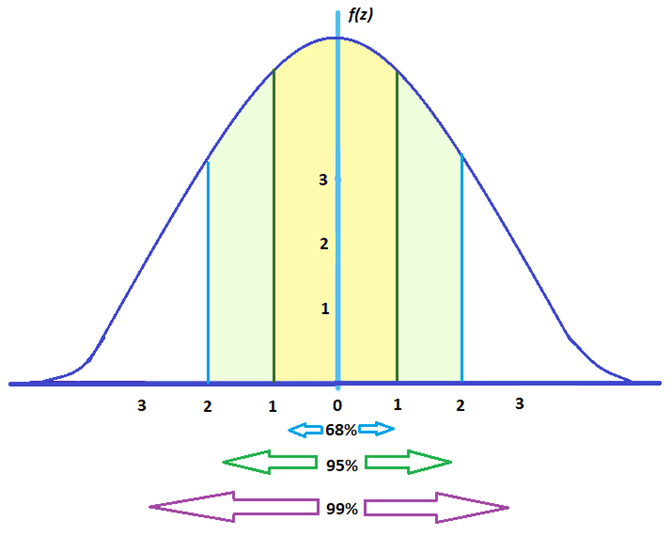
Standard Difference in Histograms
Data can also be represented through a histogram, which demonstrates numbers using bars of different heights. In a histogram, confined group numbers into ranges. A taller bar indicates a higher range.
A wider histogram suggests larger standard deviation, while a narrower one indicates lower standard deviation. See the examples below.
For instance, the post-obit images illustrate histogram orientation for observed examination scores based on 800 students, with a mean score of 100.
- English language Test Scores SD = 7.5
- Math Test Scores SD = 15.three
- Physics Test Scores SD = 30.8
Out of the three examples, physics test scores demonstrate the highest standard deviation.

Finding Standard Deviation

The basic formula for SD (population formula) is:

Where,
- σ is the standard difference
- ∑ is the sum
- X is each value in the data set
- µ is the mean of all values in a data set
- North is the number of values in the data set
Basically, standard deviation is σ = √Variance
What is Variance? Information technology is the average of the squared differences from the mean.
The standard formula for variance is:
Five = ((n1– Hateful)2 + … northwardnorthward– Mean)two) / Northward-1 (number of values in ready – 1)
How to discover variance:
- Discover the mean (get the average of the values).
- For each value, subtract the mean and square the consequence. This is the squared difference.
- Then detect the average of the squared differences.
For case, 5 friends merely measured their summit in centimeters. Using the example below, find the mean, variance, and standard departure.
| Proper noun | Meridian (cm) |
|---|---|
| Proper noun | Height (cm) |
| Corin | 157.48 cm |
| Jen | 165.099 cm |
| Raffy | 172.72 cm |
| Jessie | 152.4 cm |
| Kat | 167.64 cm |
Hateful = sum of all values / N (number of values in prepare)
Mean = 157.48 + 165.099 + 172.72 + 152.four + 167.64 / five
= 815.339 / 5
= 163.0678 cm
In this case, the mean or average top is 163.0678 cm.
To find the variance, get each divergence from the mean, square it, and then notice the boilerplate of the result.
- Corin: 163.0678 – 157.48 = 5.5878
- Jen: 163.0678 – 165.099 = -two.0312
- Raffy: 163.0678 – 172.72 = -9.6522
- Jessie: 163.0678 – 152.four = ten.6678
- Kat: 163.0678 – 167.64 = -iv.5722
σtwo = 5.5878ii + (-ii.0312)2 + (-9.6522)two + ten.6678ii + (-four.5722)two / 5
= 31.22351 + four.12577 + 93.16496 + 113.80196 + 20.90501 / v
= 263.22121 / 5
= 52.644242
The variance is 52.644242. Since the standard deviation is the square root of the variance,
σ = √52.644242
= 7.2556352
The standard deviation in this example is 7.2556 cm.
If we plot it in a graph, we can now show which heights are inside i standard difference from the mean. Now that we know the 'standard,' nosotros can decide what is the usual height, and what's too short or too alpine.
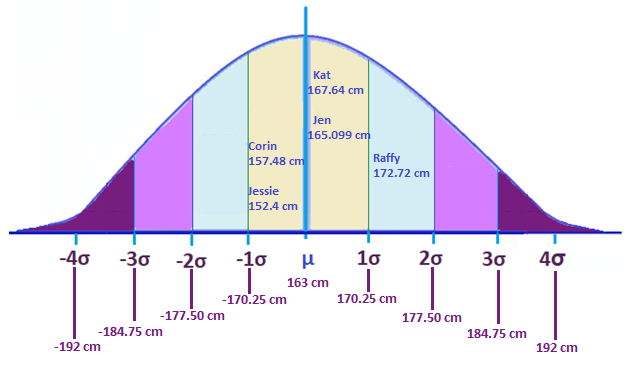
Based on this small set, Raffy is taller than the average person by over 1σ, at a pinnacle of 172.72 cm.
Of course, y'all can exercise it faster by using the calculator on peak of this folio.
You lot can also employ Excel, Google Sheets, or any similar program. This saves time if you're finding standard departure for a big set of numbers.
Just type in the formula =stdevp (), then select the numbers that you need to calculate. Run across the case beneath.
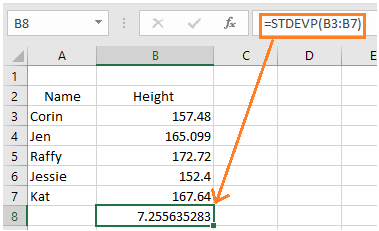
Significance and Existent-World Uses

Finding standard difference allows us to make up one's mind the normal or average range for anything that concerns a set of data. It's widely used in social science inquiry for analyzing records such as test scores, health and disease statistics, too equally data that shows patterns of cultural behavior.
In analyzing opinion surveys like election or consumer preferences, standard deviations are crucial in calculating margins of error. While it measures the consistency of a statistical hypothesis, it can as well be tested for accuracy. This helps researchers decide normal patterns of beliefs to come up with close predictions.
In finance, standard difference of price or information measures volatility in investments such equally individual securities, investment funds, and portfolios.
For example, stock markets unremarkably take high volatility (high SD), while bail markets demonstrate depression volatility (depression SD).
Moreover, one of the well-nigh significant figures in portfolio management is the Sharpe Ratio, named subsequently Nobel prize winner and economist William Sharpe.
The Sharpe Ratio uses SD to measure risk-adjusted returns, which indicates the render of an investment by measuring the amount of risk involved in producing that render.
The Bottom Line
Standard divergence (SD) is an important tool for analyzing statistical data. It provides researchers with an estimate of the mean, which is the normal range, allowing them to fix standards.
SD is used in a broad field of social science studies, including medicine, education, government, and cultural enquiry. In finance, SD measures volatility when information technology comes to analyzing stock markets.
It's a practical tool that allows researchers to measure the reliability of statistical hypothesis, also as help predict hereafter outcomes.
About the Author
Corin is an ardent researcher and author of fiscal topics—studying economical trends, how they affect populations, as well equally how to help consumers make wiser financial decisions. Her other feature articles can be read on Inquirer.cyberspace and Manileno.com. She holds a Master'southward degree in Artistic Writing from the University of the Philippines, one of the summit academic institutions in the world, and a Bachelor'due south in Communication Arts from Miriam College.
Are Y'all Positive? Cartoon

Source: https://www.calculators.org/math/standard-deviation.php
0 Response to "what is the variance? what is the standard deviation, rounded to the nearest whole number?"
Post a Comment